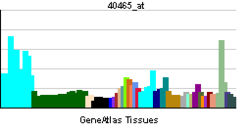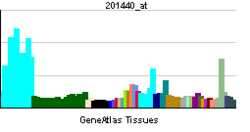- DDX23
-
Probable ATP-dependent RNA helicase DDX23 is an enzyme that in humans is encoded by the DDX23 gene.[1][2][3]
This gene encodes a member of the DEAD box protein family. DEAD box proteins, characterized by the conserved motif Asp-Glu-Ala-Asp (DEAD), are putative RNA helicases. They are implicated in a number of cellular processes involving alteration of RNA secondary structure, such as translation initiation, nuclear and mitochondrial splicing, and ribosome and spliceosome assembly. Based on their distribution patterns, some members of this family are believed to be involved in embryogenesis, spermatogenesis, and cellular growth and division. The protein encoded by this gene is a component of the U5 snRNP complex; it may facilitate conformational changes in the spliceosome during nuclear pre-mRNA splicing. An alternatively spliced transcript variant has been found for this gene, but its biological validity has not been determined.[3]
References
- ^ Teigelkamp S, Mundt C, Achsel T, Will CL, Luhrmann R (Jan 1998). "The human U5 snRNP-specific 100-kD protein is an RS domain-containing, putative RNA helicase with significant homology to the yeast splicing factor Prp28p". RNA 3 (11): 1313–26. PMC 1369570. PMID 9409622. http://www.pubmedcentral.nih.gov/articlerender.fcgi?tool=pmcentrez&artid=1369570.
- ^ Laggerbauer B, Achsel T, Luhrmann R (May 1998). "The human U5-200kD DEXH-box protein unwinds U4/U6 RNA duplices in vitro". Proc Natl Acad Sci U S A 95 (8): 4188–92. doi:10.1073/pnas.95.8.4188. PMC 22463. PMID 9539711. http://www.pubmedcentral.nih.gov/articlerender.fcgi?tool=pmcentrez&artid=22463.
- ^ a b "Entrez Gene: DDX23 DEAD (Asp-Glu-Ala-Asp) box polypeptide 23". http://www.ncbi.nlm.nih.gov/sites/entrez?Db=gene&Cmd=ShowDetailView&TermToSearch=9416.
Further reading
- Achsel T, Ahrens K, Brahms H, et al. (1998). "The human U5-220kD protein (hPrp8) forms a stable RNA-free complex with several U5-specific proteins, including an RNA unwindase, a homologue of ribosomal elongation factor EF-2, and a novel WD-40 protein.". Mol. Cell. Biol. 18 (11): 6756–66. PMC 109259. PMID 9774689. http://www.pubmedcentral.nih.gov/articlerender.fcgi?tool=pmcentrez&artid=109259.
- Jurica MS, Licklider LJ, Gygi SR, et al. (2002). "Purification and characterization of native spliceosomes suitable for three-dimensional structural analysis.". RNA 8 (4): 426–39. doi:10.1017/S1355838202021088. PMC 1370266. PMID 11991638. http://www.pubmedcentral.nih.gov/articlerender.fcgi?tool=pmcentrez&artid=1370266.
- Irobi J, Nelis E, Verhoeven K, et al. (2002). "Mutation analysis of 12 candidate genes for distal hereditary motor neuropathy type II (distal HMN II) linked to 12q24.3.". J. Peripher. Nerv. Syst. 7 (2): 87–95. doi:10.1046/j.1529-8027.2002.02014.x. PMID 12090300.
- Strausberg RL, Feingold EA, Grouse LH, et al. (2003). "Generation and initial analysis of more than 15,000 full-length human and mouse cDNA sequences.". Proc. Natl. Acad. Sci. U.S.A. 99 (26): 16899–903. doi:10.1073/pnas.242603899. PMC 139241. PMID 12477932. http://www.pubmedcentral.nih.gov/articlerender.fcgi?tool=pmcentrez&artid=139241.
- Gerhard DS, Wagner L, Feingold EA, et al. (2004). "The status, quality, and expansion of the NIH full-length cDNA project: the Mammalian Gene Collection (MGC).". Genome Res. 14 (10B): 2121–7. doi:10.1101/gr.2596504. PMC 528928. PMID 15489334. http://www.pubmedcentral.nih.gov/articlerender.fcgi?tool=pmcentrez&artid=528928.
- Andersen JS, Lam YW, Leung AK, et al. (2005). "Nucleolar proteome dynamics.". Nature 433 (7021): 77–83. doi:10.1038/nature03207. PMID 15635413.
- Olsen JV, Blagoev B, Gnad F, et al. (2006). "Global, in vivo, and site-specific phosphorylation dynamics in signaling networks.". Cell 127 (3): 635–48. doi:10.1016/j.cell.2006.09.026. PMID 17081983.
- Ewing RM, Chu P, Elisma F, et al. (2007). "Large-scale mapping of human protein-protein interactions by mass spectrometry.". Mol. Syst. Biol. 3 (1): 89. doi:10.1038/msb4100134. PMC 1847948. PMID 17353931. http://www.pubmedcentral.nih.gov/articlerender.fcgi?tool=pmcentrez&artid=1847948.
Categories:- Human proteins
- Chromosome 12 gene stubs
- Spliceosome
Wikimedia Foundation. 2010.


